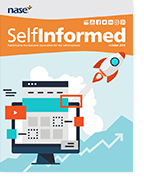TIP: How to Advertise Your Business Through Google and Facebook
Original Article: SelfInformed – October 2018
I receive emails all the time about different criteria and I try and collect the specific articles that pertain to my business and how I can pass knowledge off to my followers and customers. So I hope this helps someone when they read this, I encourage you to click the selfinformed link above after reading this article and download the PDF book. There’s helpful information in there which could benifit your business as well.
NASE talks about how to advertise your business through Google and Facebook ads
Advertising your small business sounds scary but it really is not. There are a number of ways to advertise, including signs, billboards, radio, television, Google and Facebook. Digital advertising platforms like Facebook and Google are relatively new, powerful ways to advertise that also put the power in the hands of small business owners. While you may have to hire a consultant to make a television ad or a billboard, then negotiate the rate for its display, all that power is right at your fingertips on your personal computer when it comes to digital advertising.
Google Ads (formerly AdWords)
Google Ads include both the ads that you see above and below on Google searches, and some display ads. The ads on search results pages are called search engine marketing (SEM) ads and are targeted based on search keywords, location, language and device (PC, smartphone and tablet). They can be highly effective for local businesses like lawyers, plumbers, electricians, florists, restaurants and more. However, they can also be effective for eCommerce businesses and niche businesses like ultralight plane kit builders, for example. Google Ads do generally require investing in setting up a website, however.
Facebook Ads
Facebook ads can appear in the Facebook news feed, on the sidebar, on Instagram, and a number of places now as well. They can be highly targeted with options including gender, interests, location (down to a mile), people who like your Facebook page, friends of people who like your Facebook page, and more. Facebook ads are a great place for small business owners looking to dip their feet into digital advertising and boosting posts still allows you to advertise your products and services without investing in setting up a website.
Key Digital Advertising Terminology
Digital advertising has its own set of terminology which can seem confusing at first. Do not worry — most of the terms are fairly simple, each digital marketing platform offers explanations, and a simple web search can provide all the information you need if you still have questions. These are some of the most common terms:
– Impression
An impression in digital advertising is each time someone views an advertisement. The same person can see the same ad multiple times, counting as multiple impressions.
– Frequency
The number of times the same person sees the same advertisement. A frequency of one means someone has seen an ad one time. A frequency of two means the same person has seen the ad twice. This can often be capped to a number to prevent the same person from seeing the same ad too many times.
– CTR
CTR is the click through rate of an advertisement. This is based on impressions divided by clicks. A higher CTR generally means better performance and translates into a lower cost for each click.
– CPC (PPC)
CPC stands for cost per click and describes how much each click on your running advertisement costs. A lower CPC means your ads cost less per click. This is generally a good thing, but only if the ads are still being shown to relevant customers that are interested in your product or service. CPC is sometimes described as PPC, which means pay per click, a way of describing how the ads are billed. Good targeting and good ad copy (the written text that makes up an advertisement) are essential for a good CPC.
– CPM
CPM stands for cost per thousand impressions (or mille, which means one thousand in Latin). Whereas CPC ads are charged by the click, CPM ads charge by the impression or view. Each time an ad is viewed, that counts as an impression. As with CPC ads, the better the targeting and the better the ad copy, the lower the CPM. Most digital advertising platforms can bill you either way.
– RPM
RPM stands for revenue-per-thousand-impressions. This can be difficult to calculate, especially when a business’s website traffic is low. However, let us say a digital advertising campaign drove a thousand visits to a small business’s website that resulted in a thousand page views or views of pages on the site. Those thousand visits result in fifty calls to the business inquiring about their services. Of those fifty calls, ten resulted in sales. To calculate RPM, the estimated revenue is divided by the number of page views, which is first divided by one thousand.
Website RPM = Estimated Revenue / Number of Page Views ÷ 1000
– RPV
RPV stands for revenue-per-thousand-visits. This is often a better number for small business owners to focus on than RPM, unless their business is a digital publication that relies on-page display advertising to generate revenue.
Website RPV = Estimated Revenue / Number of Page Visits ÷ 1000
– ROI
ROI stands for return on investment and is a measurement of how profitable an activity is for a business.
– Lead
A lead is a contact with a potential customer. For example, each time someone calls a business to inquire about their service counts as a lead. The filling out of contact information in a form for the same purpose also counts as a lead. Even an in-store visit counts as a lead.
– Call to Action (CTA)
Calls to action are prompts for an immediate action by a potential customer. Examples are “Call Now,” “Signup Here,” “Buy Now,” or “Email Us Here.” Every good website needs clearly defined calls to action for potential customers to initiate the sales process.
– Conversion
Conversions are the successful completions of calls to action and are intended to create customers. Examples of a conversion include an inquiry call from a potential customer, an email signup for a newsletter, a purchase on an eCommerce website or even a visit to a physical store.
– Landing Page
A landing page is a specially designed page on a website that has a clearly defined call to action. Customers are sent to landing pages from digital advertisements. A landing page should clearly define what products or services your business offers and then a call to action to initiate the sales process, ultimately resulting in some type of conversion or sale.
How to Start Google Ads
You can setup a Google Ads account at https://ads.google.com. The setup process only takes around half an hour. Google will charge your debit or credit card. The steps to setup a Google Ads account and create your first ad are as follows:
– Decide How Much to Spend
Google lets you set a daily max spend for your advertisements. Start very small. $1-$10 per day is fine. A large budget will only waste money at first as you learn how everything works, how to target your customers, and what advertisements work best for your customers. You can always increase this later, once you start to see results.
– Choose a Target Audience
— Locations
This is where your knowledge of your customers comes in handy. If you have a local business, you will want to make sure you are only targeting customers in your area. The default is the United States and Canada, but you can set it to whatever country or city you want to target.
— Networks
The options here are search (which must always be selected) and display. Display ads appear on websites that Google thinks match the keywords you set. For example, if someone is reading an article on a blog that talks about model trains and your ads relate to model trains, Google would serve your ads on the website if it has the appropriate ad units setup on its pages.
— Keywords
These are the words that trigger your advertisement when people search for them through Google. Keyword research is important. Google also shows the monthly search volume for your selected locations and keywords.
– Set Your Bid
There are two options here: automatic and manual. I recommend starting with automatic to get a feel for how much your CPC will be. You can always set this to manual later. If your manual bid is too low, your ad will either end up lower in search results or not be displayed at all.
– Write Your Ad
This is fairly straightforward and Google displays a mockup of what the ad will look like. You want your ad to stand out from the others but not be misleading. Clearly explain your product or service.
– Enter Your Business and Billing Information
Google uses this to charge you. It is also important to set the correct time zone for reporting purposes. Google also occasionally offers advertising credits via email and many website hosting companies offer them with new accounts.
– Start the Campaign and Track Performance
After you go through all the steps, it is time to start tracking performance. Google offers some performance tracking information in its advertising dashboard, but you should also link the ad account to your Google Analytics account. That option is in Google Analytics settings. This lets you see how much each visit costs, where on your website they go, and if they complete any conversions, which can be tracked as “goals.”
How to Start Facebook Ads
Facebook offers two ways to advertise: boosting posts that are on your page and Facebook Ad Manager. Ad Manager offers many more options and is recommended if you have time to dive into it. I recommend starting with boosted posts and seeing how they perform.
– Boosted Posts
To create a boosted post, first create a post on your Facebook page. There is a “Boost Post” button that appears in the lower right hand side of the post when viewed on a PC. The steps are straightforward and include total budget, delivery options and targeting. You will be prompted to enter your billing information after you have setup your ad. Start small. Measure performance. Repeat.
– Facebook Ad Manager
Facebook Ad Manager is accessible through clicking “Manage Ads” in the menu opened by clicking the downward facing arrow in the upper right hand corner of Facebook when on a PC. You will have to create a Facebook Ad account, enter your billing information, and then you will be presented with a number of options to boost posts, create new posts to boost, or promote links to your website. There are quite a few options in Facebook Ad Manager compared to Google Ads. As with boosted posts, it is important to start with a small budget and scale as you start to see profitable results. Make sure your targeting information is correct. You can spend all the money in the world and still not get a sale if you are targeting the wrong customers.
Tracking the Performance of a Digital Advertising Campaign
The easiest way to track the performance of a digital advertising campaign and the overall performance of a business’s website and/or smartphone app is through Google Analytics. Google Analytics is a free tool from Google that can tell you where every visit to your website comes from. Another important tool is Google Search Console, which focuses on how your website interacts with searches on Google.
Besides these two tools from Google, Facebook’s Ad Manager reporting tools is invaluable for ads running on that platform. A simple Google Sheets spreadsheet can be used to organize daily spend versus RPM or RPV metrics, leads generated per day, and other metrics. Pay attention to metrics like CPC and conversions. It does not make sense to spend $10 to generate a conversion if your profit margin before advertising is less than that.
Both Google and Facebook offer training in the form of Google Ads Certification and Facebook Blueprint. Google’s training is free though Facebook’s can be audited for free as well. Another invaluable training Google offers is Google Analytics Certification, which is also free.
Once you have setup and run your first Google Ads or Facebook Ads campaign, calculate the performance. Did the ads generate any conversions or sales? Were you able to accurately determine the ROI? Did you target your potential customers to the best of your ability? Do you need to perform market research to better target your potential customers? Digital advertising should always have a clear result and a positive ROI. Happy advertising!



